Medical Students Embrace Cura Personalis in Foot Clinics for the Unhoused
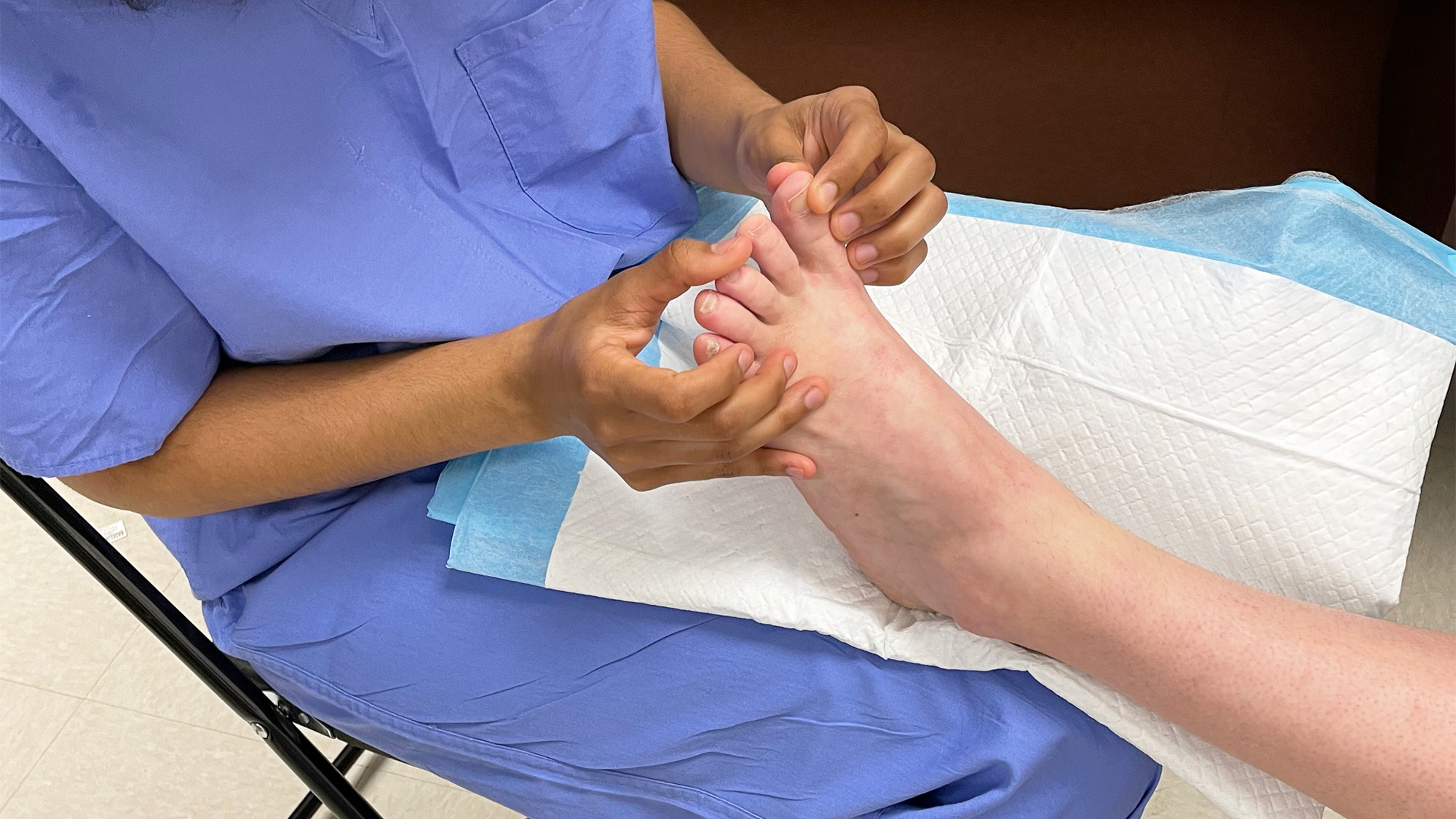
Posted in News Stories | Tagged community outreach, cura personalis, HOYA Clinic, HOYA Foot Care Clinic, service to others
(December 15, 2023) — Medical students who volunteer with the HOYA Foot Care Clinic not only provide foot exams and triage for the underserved, unhoused population of Washington DC, they also strive to create life-affirming encounters with patients.
“As we serve each of our patient’s feet, we realize that these feet carry the burdens of a whole, complex, and beautiful life,” states the organization’s training materials.
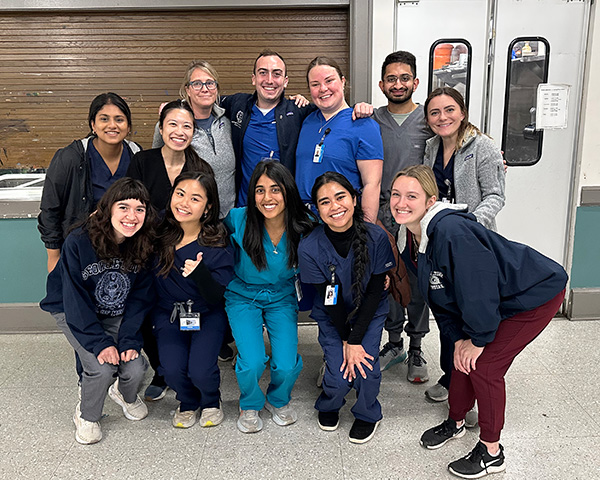
The HOYA Foot Care Clinic (FCC) was founded in 2020 as a part of the School of Medicine’s HOYA Clinic, a student-run, free clinic that aims to improve health access for DC’s most vulnerable populations.
Two-thirds of people experiencing homelessness will encounter foot problems, according to the FCC. Data show that unhoused people walk an average of 5 miles a day, often enduring harsh environmental conditions, and their access to podiatric care and protective shoes is limited.
“We really see the foot as a reflection of your overall health,” said Nina Kishore (M’26), one of the FCC’s founding members. “With a thorough examination of the foot, we can identify potential health concerns like poor blood circulation, which can be a sign of cardiovascular disease; tingling and numbness, which can be a sign of peripheral neuropathy; yellow toenails, which can be a sign of infection; and poor wound healing, which can be a sign of diabetes.
“The population we serve might have other health issues or be facing other pressing needs like securing housing or food, and may not have the time or space to reflect on why their foot is hurting,” added Kishore.
Improving Foot Health, One Clinic at a Time
Kishore passed the baton to Shankar Thiru (M’26) and John DiBello (M’26), who alongside HOYA Clinic’s Development Coordinator Mary Tresvalles (M’26), worked to greatly expand the group’s mission and work. Abigail Escobar (M’27), Nori Pham (M’27), Shalin Bhatt (M’27) have newly taken up FCC leadership roles in the past few months.
FCC student leadership set a goal of organizing 12 clinics and serving 400 people annually. The 21 medical student volunteers of FCC have a minimum requirement of participating in two events in the fall and three in the spring. Each clinic requires a three- to four-hour time commitment.
Student volunteers encounter 30 to 40 people at each clinic. The initial community partner for FCC was the Harriet Tubman Women’s Shelter. FCC still regularly holds clinics at this site, as well as five other community partner site locations. Since the fall of 2022, FCC has seen 317 patients.
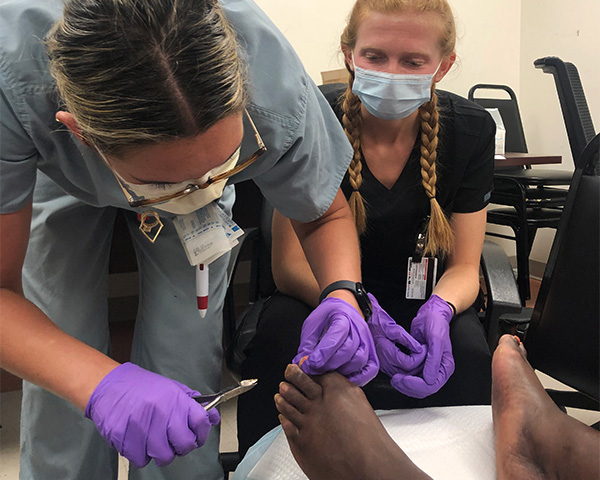
“It’s hard to make the sacrifice to operate a clinic for six hours in a day as a medical student, when the demands placed on you are so great,” said Kishore. “These current student leaders, who have worked so hard to expand FCC this year, are rare individuals who are really willing to serve others in the most altruistic and genuine way.”
During clinics, student volunteers provide foot exams, education on diabetes, and referrals for podiatry and other health concerns. They also distribute supplies including fresh socks, nail clippers, antifungal powder and shoes.
“From a student experience, you are able to practice skills such as doing a dermatological exam, as well as screen folks for diabetes,” said DiBello.
The medical students also provide triage for open wounds and referrals when necessary.
“The reality of an open wound with an unhoused person is that the risk of infection is high, so we may be saving that limb for that person by addressing it,” said DiBello.
Basic Interventions That Make a Difference

Spending a lot of time in damp shoes and socks can lead to the development of foot fungus and overgrown toenails.
“We hear from people in clinics that it’s hard to keep their socks and shoes dry,” DiBello said. “People also fear taking off their shoes at night in shelters or other places they may be sleeping.”
“We see people in clinics whose toenails are so thick that even if they have access to one, they aren’t able to clip them with a nail clipper from CVS,” explained Escobar, who says large medical clippers are often necessary.
“One patient had a really thick nail that started to grow outwards in a left turn and enter the second toe, forming an ulcer in the second toe,” said DiBello. “I clipped the nail back to baseline and it really was a basic intervention that a student can do that made a world of a difference in that person’s life.”
‘A Healing Encounter’
Student volunteers also provide Epsom salt foot soaks and foot washes for people at the clinics. While those treatments aren’t medically necessary, they help build trust between the patients and volunteers.
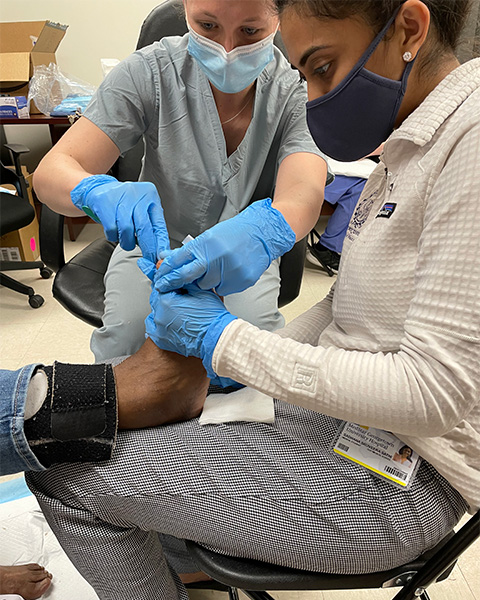
“There’s an intimate association in touching a person’s foot that might not be touched often,” said Kishore. “There’s a trust that’s being built there with someone who may have faced a lot of hardships, and by showing that you are not hesitant to touch them, you are signaling that you are accepting them without judgment.”
Students also found that through holding someone’s foot, lines of communication open.
“Holding someone’s foot and examining a vulnerable part of the body really opens up people to share things, not just about their medical history, but about their struggles,” said Escobar. “Taking the time for the foot soaks and washes gives people the chance to feel a little more human, a little more dignified, and hopefully find a renewed sense of self.”
“There’s also more time for medical communication when you are drying someone’s foot,” DiBello added. “We are able to talk about the importance of drying in between toes to prevent fungus and how being a chronic smoker impacts blood vessels while you are touching the place where blood is running through their feet.”
DiBello and Escobar envision the healing encounters at the foot clinics as part of the School of Medicine’s goal to create physician healers to care for the physical and spiritual needs of the patient.
“Several patients have brought up the spiritual nature of our encounters in the clinic,” said Escobar. “I had a patient, while I was washing their feet, look at me and say, ‘What you are doing makes me think of when Mary washed the feet of Jesus.’”
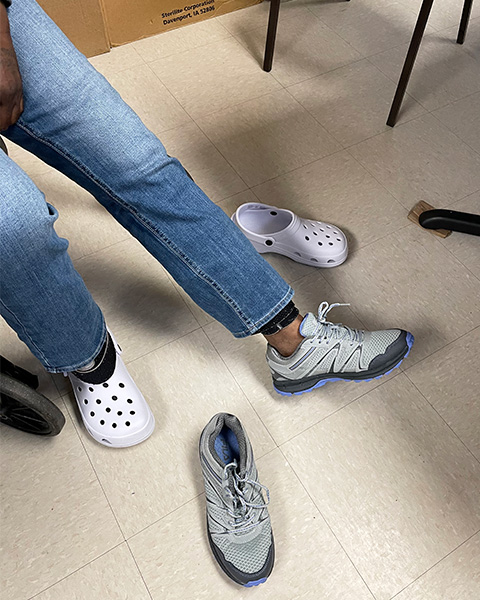
At the heart of the healing encounter is human connection and caring for the whole person.
“Being able to touch someone’s foot and shave down a callus or cut a nail may leave them feeling a little better physically,” said Kishore. “But sometimes it’s just that human connection that will be the lasting part of the encounter, and that connection is emblematic of cura personalis and what Georgetown stands for.”
Fundraising and Future Sites
The FCC fundraises to organize the clinics and purchase supplies like nail clippers, antifungal powder, and shoes to distribute to patients.
“We estimated that $4,000 to $5,000 will help us reach our goal of serving 400 people a year,” said DiBello.
The FCC’s next local foot clinic will be January 20 at the Georgetown Ministry Center. Donations can be designated for the HOYA Foot Care Clinic at Georgetown’s Called to Be giving website.
Heather Wilpone-Welborn
GUMC Communications
